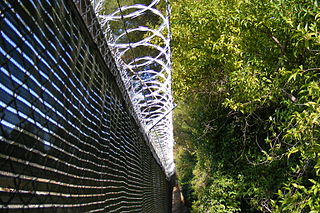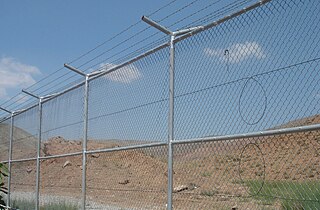
A fence is a structure that encloses an area, typically outdoors, and is usually constructed from posts that are connected by boards, wire, rails or netting. A fence differs from a wall in not having a solid foundation along its whole length.

Barbed tape or razor wire is a mesh of metal strips with sharp edges whose purpose is to prevent trespassing by humans. The term "razor wire", through long usage, has generally been used to describe barbed tape products. Razor wire is much sharper than the standard barbed wire; it is named after its appearance but is not razor sharp. The points are very sharp and made to rip and snag clothing and flesh.

Physical security describes security measures that are designed to deny unauthorized access to facilities, equipment, and resources and to protect personnel and property from damage or harm. Physical security involves the use of multiple layers of interdependent systems that can include CCTV surveillance, security guards, protective barriers, locks, access control, perimeter intrusion detection, deterrent systems, fire protection, and other systems designed to protect persons and property.

The Gaza–Israel barrier is a border barrier located on the Israeli side of the Gaza–Israel border. Before the 2023-24 Israel-Hamas war, the Erez Crossing, in the north of the Gaza Strip, used to be the only crossing point for people and goods coming from Israel into the Gaza Strip, with a second crossing point, the Kerem Shalom border crossing, used exclusively for goods coming from Egypt, as Israel didn't allow goods to go directly from Egypt into Gaza through the Egypt–Gaza border, except for the Salah Al Din Gate, opened in 2018.

The Mexico–United States border wall is a series of vertical barriers along the Mexico–United States border intended to reduce illegal immigration to the United States from Mexico. The barrier is not a continuous structure but a series of obstructions variously classified as "fences" or "walls".

A Jersey barrier, Jersey wall, or Jersey bump is a modular concrete or plastic barrier employed to separate lanes of traffic. It is designed to minimize vehicle damage in cases of incidental contact while still preventing vehicle crossovers resulting in a likely head-on collision. Jersey barriers are also used to reroute traffic and protect pedestrians and workers during highway construction. They are named after the U.S. state of New Jersey which first started using the barriers as separators between lanes of a highway in the 1950s.

A security alarm is a system designed to detect intrusions, such as unauthorized entry, into a building or other areas, such as a home or school. Security alarms protect against burglary (theft) or property damage, as well as against intruders. Examples include personal systems, neighborhood security alerts, car alarms, and prison alarms.

An electric fence is a barrier that uses electric shocks to deter people and/or other animals from crossing a boundary. The voltage of the shock may have effects ranging from discomfort to death. Most electric fences are used for agricultural fencing and other forms of non-human animal control, although they are also used to protect high-security areas such as military installations or prisons, where potentially-lethal voltages may be used. Virtual electric fences for livestock using GPS technology have also been developed.

A prison escape is the act of an inmate leaving prison through unofficial or illegal ways. Normally, when this occurs, an effort is made on the part of authorities to recapture them and return them to their original detainers. Escaping from prison is also a criminal offense in some countries, such as the United States and Canada, and it is highly likely to result in time being added to the inmate's sentence, as well as the inmate being placed under increased security that is most likely a maximum security prison or supermax prison. In Germany, and a number of other countries, it is considered human nature to want to escape from a prison and it is considered as a violation of the right of freedom, so escape is not penalized in itself.

The Secure Fence Act of 2006, also labelled H.R. 6061, is an act of the United States Congress which authorized and partially funded the construction of 700 miles (1,125 km) of fencing along the Mexican border. The Act was signed into law on October 26, 2006, by U.S. President George W. Bush, who stated at the time that the Act would "help protect the American people", would "make our borders more secure", and was "an important step toward immigration reform".

The Tactical Automated Security System (TASS) is a U.S. Air Force intrusion detection and surveillance system used for security monitoring around fixed site airbases, semi-permanent Forward Operating Bases (FOBs), and other mobile tactical deployments.

A Bremer wall, or T-wall, is a twelve-foot-tall (3.66 m) portable, steel-reinforced concrete blast wall of the type used for blast protection throughout Iraq and Afghanistan.

Demarcation of a perimeter, when the protection of assets, personnel or buildings is required, is normally affected by the building of a perimeter fence system. The level of protection offered varies according to the threat level to the perimeter. Different types of perimeter fencing include:

The PJT-531 Battle Field Surveillance Radar – Short Range(BFSR-SR) is a man portable 2D short-range battlefield and perimeter surveillance radar developed by the Indian Defence Research and Development Organisation (DRDO). The BFSR has been designed by DRDO's Bengaluru-based laboratory, the Electronics and Radar Development Establishment (LRDE) and is being manufactured by Bharat Electronics Limited (BEL).
Physical security information management (PSIM) is a category of software that provides a platform and applications created by middleware developers, designed to integrate multiple unconnected security applications and devices and control them through one comprehensive user interface. It collects and correlates events from existing disparate security devices and information systems to empower personnel to identify and proactively resolve situations. PSIM integration enables numerous organizational benefits, including increased control, improved situation awareness and management reporting. Ultimately, these solutions allow organizations to reduce costs through improved efficiency and to improve security through increased intelligence.

Future Fibre Technologies (FFT) is a fiber optic sensing technologies company based in Melbourne, Australia, with its US head office in Mountain View, California, Middle East head office in Dubai, Indian head office in New Delhi and European head office in London. Founded in 1994, Future Fibre Technologies product line provides optical fiber intrusion detection systems for perimeters, buried oil and gas pipelines and data communication networks.

Counter-IED equipment are created primarily for military and law enforcement. They are used for standoff detection of explosives and explosive precursor components and defeating the Improvised Explosive Devices (IEDs) devices themselves as part of a broader counter-terrorism, counter-insurgency, or law enforcement effort.

The Syria–Turkey barrier is a border wall and fence under construction along the Syria–Turkey border built in an attempt at preventing illegal crossings and smuggling from Syria into Turkey.

A perimeter intrusion detection system (PIDS) is a device or sensor that detects the presence of an intruder attempting to breach the physical perimeter of a property, building, or other secured area. A PIDS is typically deployed as part of an overall security system and is often found in high-security environments such as correctional facilities, airports, military bases, and nuclear plants.
Senstar Corporation develops and manufactures perimeter intrusion detection systems, video management software, security lighting, personal duress systems, and access control software for the physical security and video surveillance industries. Its headquarters are located in Ottawa, Ontario. Senstar products protect facilities around the world, including critical infrastructure sites, military bases, nuclear power plants, airports, personal estates, borders, and correctional facilities.

















